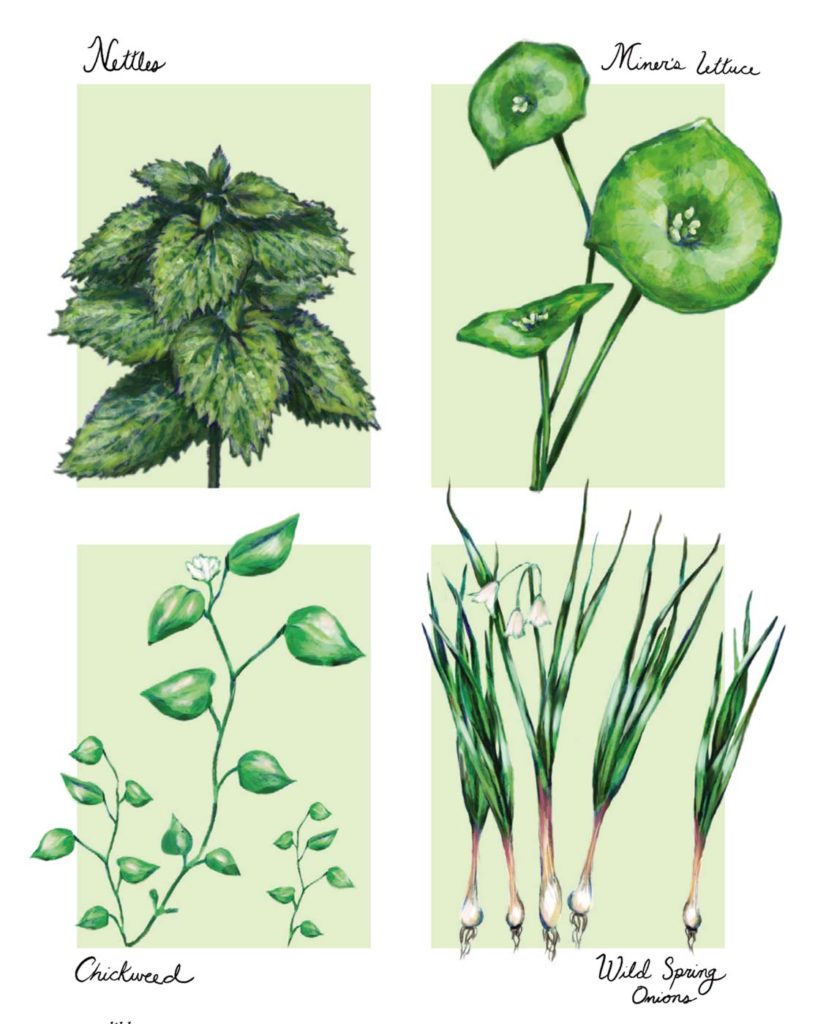ILLUSTRATION BY SOPHIE WOOD BRINKER

A Mediterranean-inspired recipe to get you outdoors
Winter rains bring the vigorous spring greens that fill this rich, locally foraged spanakopita. It’s a California-specific version of the classic savory Greek pie that includes a medley of miner’s lettuce, chickweed, spring onions and nettles. Any number of edible spring greens can be substituted and proportions can vary depending on what’s available. The act of harvesting greens from neighborhood open spaces can be nourishing in its own right, as it helps foster a deep sense of belonging to a place. So get out there and give it a try! The plants in this recipe tend to grow abundantly all over the state, so sourcing is unlikely to be too big an issue.
To find the foraged ingredients in this recipe, start looking around a few weeks after the first seasonal rains. Once you discover your local patches of these delicious powerhouses, a delightful anticipation for their ripeness will likely set in and you might just find yourself returning frequently to check on them.
MINER’S LETTUCE
Claytonia perfoliata, or winter purslane, grows commonly throughout much of California. Over its maturation cycle, leaves develop from spears into spades, then hearts and lastly, discs from which flower stalks eventually sprout. The gently flavored plant is best harvested pre-seeding when the stems are still crunchy and not highly fibrous. Leaves and stems of this watery annual make an excellent substitute for spinach, which is classically used in the pie.
CHICKWEED
Stellaria media is similarly mild in flavor and tends to grow alongside miner’s lettuce. This annual plant is best harvested when the patch has matured into a dense mat, its leaves are grown to roughly the size of a fingernail and flowering is in its early stage. Once the plant goes to seed, its stalks become woody and unpalatable. All aerial parts are edible. Be sure to identify this properly and not confuse it with dangerous lookalike, scarlet pimpernel.
SPRING ONION
Allium triquetrum, or three-sided leek, is both beloved to foragers and chefs and despised by ecologists. This invasive onion easily outcompetes other more delicate low-lying plants and often takes over hillsides, making for easy forage in late winter and early springtime. Potential lookalikes include soaproot and camas lily; identify spring onion by making sure the spade leaf has three sides and that the crosssection looks a bit like a malformed triangle. Edible parts of the onion include the young bulb, shoots and flower. Once it goes to seed, the flower becomes undesirable and the bulb develops a thick skin around it, making it sub-par for most dishes.
NETTLES
Urtica dioica is a perennial that sends out new sprouts in winter for a harvest that typically lasts into summer. While some opt to wear leather gloves to avoid the stingers, proper handling of the stem during harvest will minimize the stingers entering the skin. Nettles’ stingers grow upward and outwards from the stalk; at your own discretion, gently stroke upwards on the stalk to grasp the body of the stem, avoiding pressing downwards to ensure stingers do not enter the skin. With scissors or a knife, slice the nettle right above the leaf node, directly into your collection basket. Potential lookalikes include hedgenettle; one light touch of the leaves with the back of your hand will tell you which of the two it is, as nettle will bite back.

About the author
Alexandra Hudson is a California-born clinical herbalist, wild foods chef and holistic educator. She lives with her family out in the Day Valley redwoods, where she tends to her land and offers classes and sessions to clients. For more information on Hudson’s practice and classes, visit alchemistress.world.
- Alexandra Hudsonhttps://www.ediblemontereybay.com/author/alexandrahudson/
- Alexandra Hudsonhttps://www.ediblemontereybay.com/author/alexandrahudson/
- Alexandra Hudsonhttps://www.ediblemontereybay.com/author/alexandrahudson/
- Alexandra Hudsonhttps://www.ediblemontereybay.com/author/alexandrahudson/


